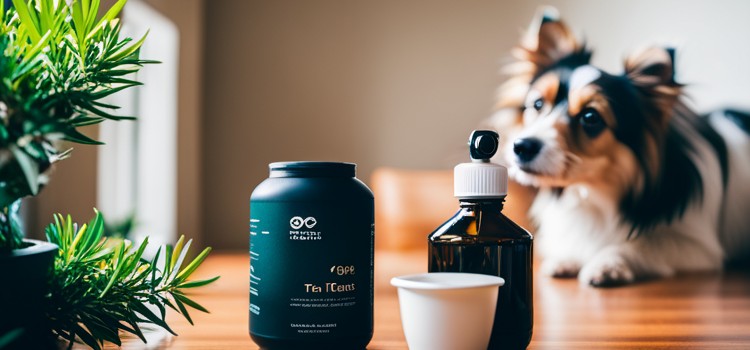As an Amazon Associate committed to the mission of improving the lives of our readers, Live-Clear.com receives a small commission from eligible purchases made through our affiliate links. This revenue enables us to keep producing insightful articles and other material.
Elevate canine bath time with a precise tea tree oil infusion. Expert advice on the ideal tea tree oil dosage for effective dog grooming Enhance your fur health now!

Introduction
When it comes to grooming our furry friends, using the right products is essential. Tea tree oil, derived from the leaves of the tea tree, is known for its potential benefits in promoting skin health. However, when using tea tree oil for dogs, it’s crucial to exercise caution and moderation. In this guide, we’ll delve into the considerations for adding tea tree oil to dog shampoo, the benefits it offers, and the proper dosage to ensure your dog’s safety and well-being.
Understanding Tea Tree Oil and Its Benefits for Dogs
What is Tea Tree Oil?
The Melaleuca alternifolia plant’s leaves are the source of the essential oil known as tea tree oil. It has been recognized for its potential antibacterial, antifungal, and anti-inflammatory properties.
Benefits of Tea Tree Oil for Dogs
Tea tree oil can offer various benefits for dogs, including soothing skin irritations, repelling pests, and promoting a healthy coat. Its natural properties can help address issues such as itching, dryness, and minor fungal infections.
Diluting Tea Tree Oil for Dog Shampoo
Importance of Dilution
Tea tree oil is potent and should always be diluted before applying it to your dog’s skin or coat. Undiluted tea tree oil can be too strong and may cause adverse reactions.
Recommended Tea Tree Oil Concentration
A safe concentration of tea tree oil in dog shampoo ranges from 0.1% to 0.5%. This translates to about 1 to 5 drops of tea tree oil per 1 ounce of shampoo.
Choosing the Right Shampoo Base
Selecting a mild and gentle shampoo base is essential when incorporating tea tree oil. Look for shampoos that are specifically formulated for dogs and free of harsh chemicals.
Calculating the Correct Amount of Tea Tree Oil
Considering the Dog’s Size
The amount of tea tree oil you add to the shampoo depends on your dog’s size. Smaller dogs require fewer drops, while larger dogs can tolerate slightly more.
Safe Dosage Guidelines
For small dogs, start with 1 to 2 drops of tea tree oil per 1 ounce of shampoo. For medium to large sized dogs, you can increase the amount to 3 to 5 drops.
Measuring Tea Tree Oil Accurately
Use a dropper to measure the tea tree oil accurately. This ensures that you’re adding the right amount to achieve the desired concentration.

Steps to Mixing Tea Tree Oil with Dog Shampoo
Step 1: Gathering Your Supplies
Collect the dog shampoo, tea tree oil, a mixing container, and a dropper.
Step 2: Calculating the Amount of Oil
Based on your dog’s size, calculate the number of drops needed to achieve the recommended concentration.
Step 3: Blending the Ingredients
Mix the calculated amount of tea tree oil with the dog shampoo thoroughly. Ensure even distribution for effective results.
Precautions and Potential Risks
Allergies and Sensitivities
Some dogs may be allergic or sensitive to tea tree oil. Perform a patch test to rule out any adverse reactions before using the shampoo.
Negative Effects of Overuse
Using too much tea tree oil can lead to skin irritation, itching, or even toxicity. Stick to the recommended guidelines to prevent such issues.
Alternatives to Tea Tree Oil
If your dog is sensitive to tea tree oil or you prefer an alternative, consider using other natural ingredients like chamomile or oatmeal.
Spot Testing and Observing Effects
Conducting a Patch Test
Apply a small amount of diluted shampoo to a small area of your dog’s skin and monitor for any redness, itching, or irritation.
Monitoring for Adverse Reactions
After using the tea tree oil shampoo for the first time, keep an eye on your dog for any adverse reactions. If any problems appear, stop using the product right away.
Incorporating Tea Tree Oil Shampoo into Your Dog’s Routine
Frequency of Use
Use the tea tree oil shampoo once every two to four weeks, depending on your dog’s needs and skin condition.
Bathing Techniques
Follow proper bathing techniques, ensuring that the shampoo reaches the skin and coat thoroughly. Keep your distance from the eyes and ears.
Observing Long-Term Benefits
With regular and proper use, you may notice improvements in your dog’s coat condition, skin health, and overall comfort.

Conclusion
Tea tree oil can be a valuable addition to your dog’s grooming routine, offering potential benefits for skin health. By understanding the proper dosage and precautions, you can use tea tree oil-infused shampoo safely and effectively.
Frequently Asked Questions (FAQs)
Tea tree oil can be safe for dogs when properly diluted and used in moderation. However, some dogs may be sensitive, so it’s essential to perform a patch test before use.
It’s best to avoid using tea tree oil on puppies, as their skin is more sensitive. For appropriate grooming supplies, speak with your veterinarian.
If your dog experiences any adverse reactions, such as redness or itching, discontinue use immediately and consult your veterinarian.
No, increasing the amount of tea tree oil can lead to adverse effects. Stick to the recommended guidelines to ensure your dog’s safety.
You can find tea tree oil at health stores, online retailers, or pet supply shops. Ensure you’re purchasing high-quality, pure tea tree oil.
Amazon and the Amazon logo are trademarks of Amazon.com, Inc, or its affiliates.


